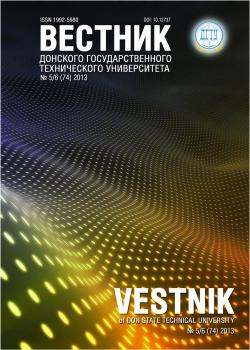The work objective is to study the impact of the drill design value and geometrics on the quality of the processed holes, the efficiency, and the machining dynamics of the high-strength polymer composite — fiberglass plastic reinforced by titanium foil. Packs of the reinforcing layers made from the titanium foil or carbon fiber tapes are often used in the highly-loaded polymer composite structures. Processing in several operations and the application of sharp-ground tools provide the required dimensional accuracy, the surface macro- and microgeometry of the hole, and allow avoiding the delamination. The process of drilling fiberglass laminates under different patterns of HSS drills sharpening is studied. The data obtained allow determining the optimum type of instrument and operation mode taking into account the dependence of the high-altitude roughness parameters, the nature and amount of delamination in the entry (exit point) of the drill. The vibroactivity of the drilling process and its relationship with the quality metrics are studied using the computer-aided torque-sensing system. Some proposals for improving the hole-making technology applying to the glass-fiber spars of the main and tail helicopter rotors are developed.
glass fiber reinforced plastic (GFRP), delamination, double-angle drill sharpening, vibroactivity, torque effect, fiberglass drilling.
На современном этапе развития производства отмечается все более активное использование полимерных композиционных материалов (ПКМ) в наукоемких отраслях — таких, как: авиастроение, кораблестроение, ракетно-космическая промышленность, автомобилестроение, энергетика, медицина и т. д. Как известно, выпуск компонентов ПКМ, а также соответствующих деталей и агрегатов предусматривают наличие в стране мощной научной и производственной базы. Значительный технологический и коммерческий потенциал ПКМ объясняется такими их свойствами, как:
— высокие удельные прочность, жесткость и модуль упругости;
— хорошая демпфирующая способность и коррозионная стойкость;
— усталостная прочность и низкий коэффициент теплового расширения.
Отличные прочностные характеристики и низкая удельная плотность композитов по сравнению с металлами позволяют уменьшить массу готовой детали без потери жесткости и надежности, а также получить изделия с заданными физико-механическими свойствами.
1. Bulanov, I.М., Vorobey, V.V. Tekhnologiya raketnykh i aerokosmicheskikh konstruktsiy iz kompozitsionnykh materialov: uchebnik dlya vuzov. [Rocket and aerospace composite structures technology.] Moscow: Izd-vo MGTU im. N.E. Baumana, 1998, 516 p. (in Russian).
2. 787. It Reinvents Fleet Plans and Transforms Business Plans. Boeing. Available at: http://www.boeing.com/boeing/commercial/787family/background.html (accessed: 21.01.2016).
3. Stepanov, А.А. Obrabotka rezaniem vysokoprochnykh kompozitsionnykh polimernykh materialov. [Machining of high-strength composite polymer materials.] Leningrad: Mashinostroenie, 1987, 175 p. (in Russian).
4. Lopez-Arraiza, A., et al. Experimental analysis of drilling damage in carbon-fiber reinforced thermoplastic lami-nates manufactured by resin transfer molding. Journal of Composite Materials, 2012, vol. 46, iss. 6, pp. 717-725.
5. Khashaba, U.A., et al. Drilling analysis of woven glass fiber-reinforced/ epoxy composites. Journal of Composite Materials, 2013, vol. 47, iss. 2, pp. 191-205.
6. Ghasemi, F.A., et al. Effects of Drilling Parameters on Delamination of Glass-Epoxy Composites. Australian Journal of Basic and Applied Sciences, 2011, vol. 5, iss. 12, pp. 1433-1440.
7. Kilickap, E. Investigation into the effect of drilling parameters on delamination in drilling GFRP. Journal of Rein-forced Plastics and Composites, 2010, vol. 29 (23), pp. 3498-3503.
8. Okutan, E., et al. Study on the Derivation of Parametric Cutting Force Equations in Drilling of GFRP Composites. Journal of Mechanical Engineering, 2013, vol. 59 no. 2, pp. 97-105.
9. Murugesh, M.-C., Sadashivappa, K. Influence of filler material on Glass fiber/ epoxy composite laminates during drilling. International Journal of Advances in Engineering & Technology, 2012, vol. 3, iss. 1, pp. 233-239.
10. Durao, L.-M., et al. Comparative analysis of drills for composite laminates. Journal of Composite Materials, 2011, vol. 46 (14), pp. 1649-1659.
11. Gaitonde, V.-N., et al. A study aimed at minimizing delamination during drilling of CFRP composites. Journal of Composite Materials, 2011, vol. 45 (22), pp. 2359-2368.
12. Wang, B., et al. Mechanism of damage generation during drilling of carbon/epoxy composites and titanium alloy stacks. Engineering Manufacture, 2014, vol. 228, iss. 7, pp. 698-706.
13. Isbilir, O., Ghassemieh, E. Delamination and wear in drilling of carbon-fiber reinforced plastic composites using multilayer TiAlN/TiN PVD-coated tungsten carbide tools. Journal of Reinforced Plastics and Composites, 2012, vol. 31 (10), pp. 717-727.
14. Dyakonov, V.P. MATLAB 6.5/7.0 + Simulink 5/6. Obrabotka signalov i proektirovanie fil´trov. [Signal processing and filter designing.] Moscow: Solon-press, 2005, 576 p. (in Russian).





